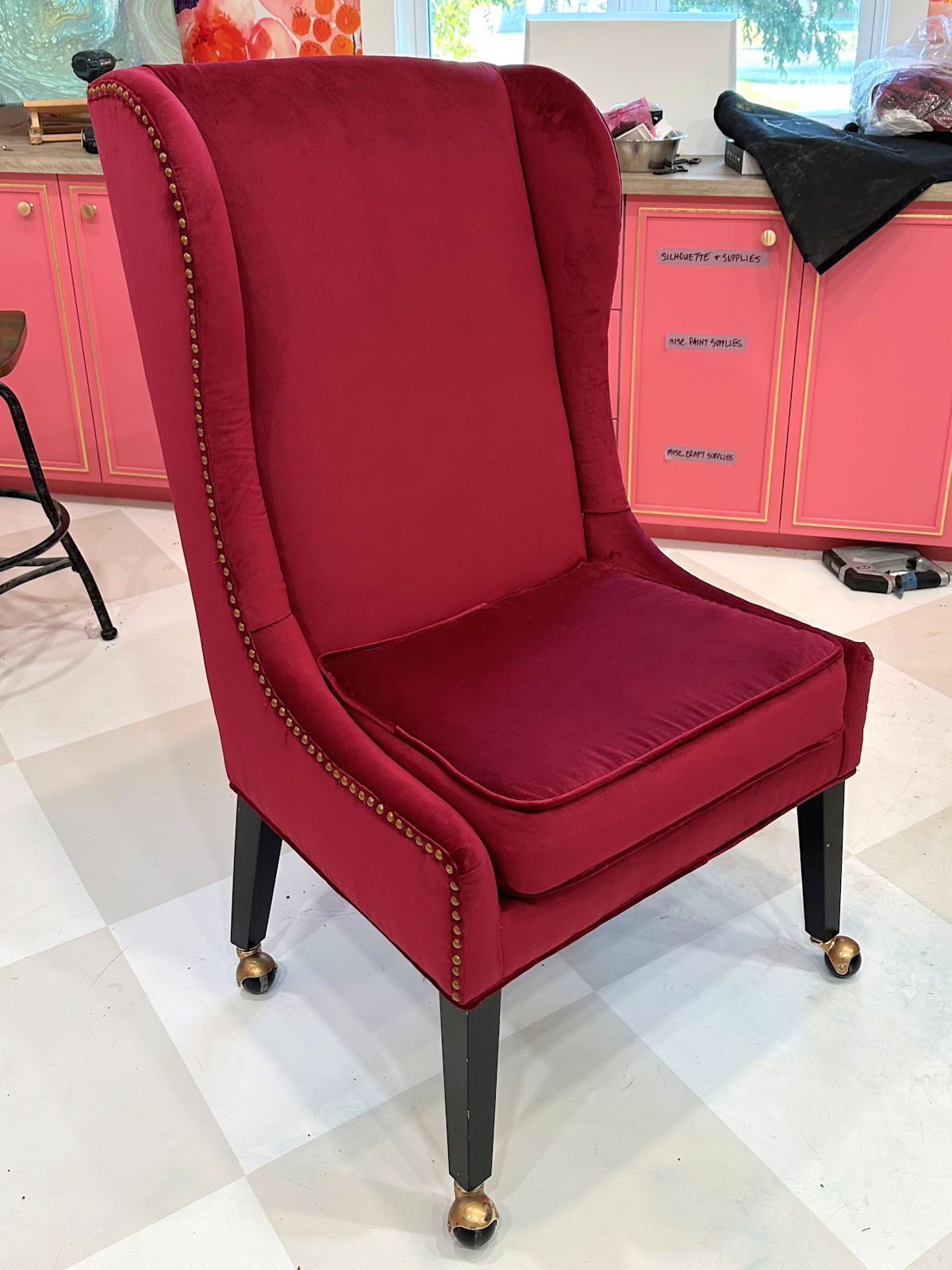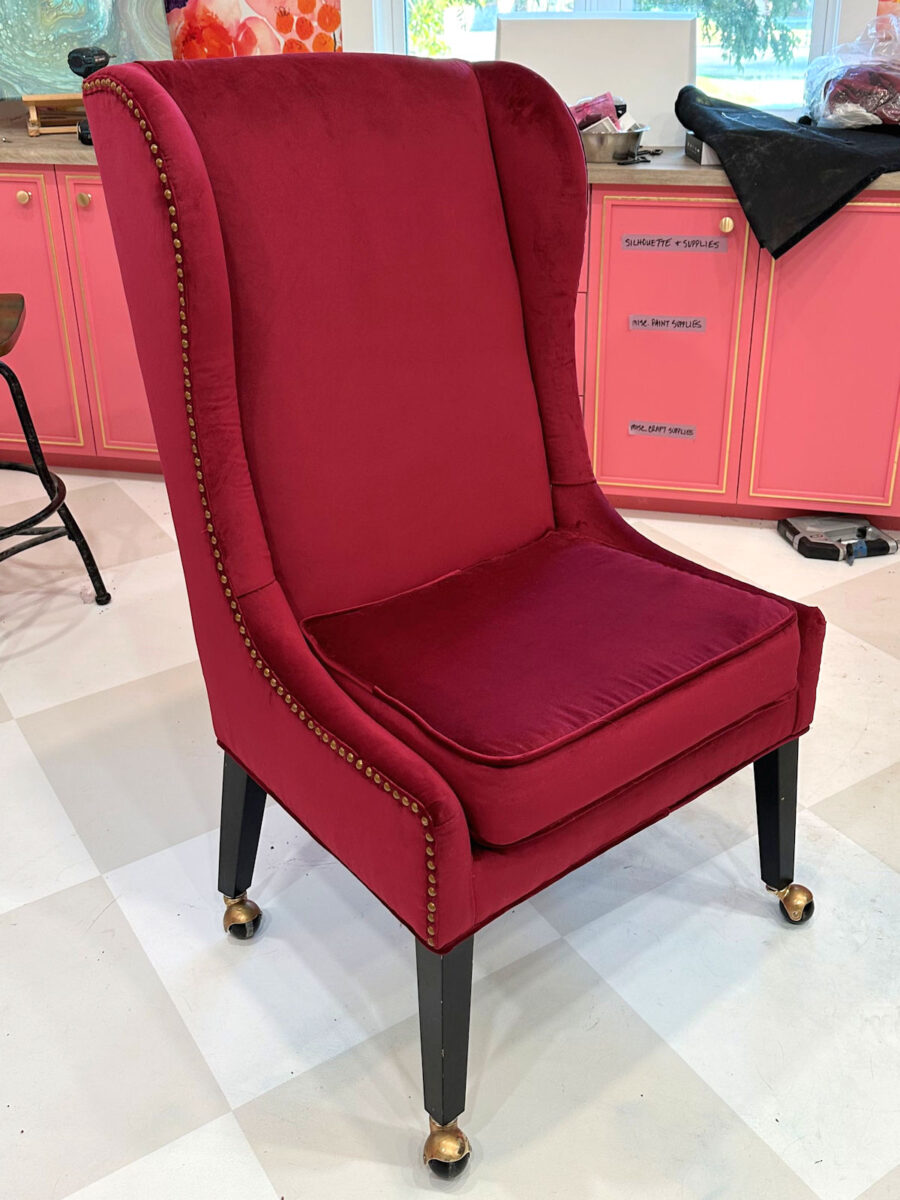
My mother and I’ve efficiently completed reupholstering my desk chair, and it turned out so good! It’s not excellent, however it’s fairly good for 2 non-professionals who do reupholstery tasks possibly as soon as each three or 4 years.
Right here’s a have a look at the completed chair. Properly, the upholstery is completed, however I’ve determined that I wish to swap out the legs for a type of desk chair swivel bases, so these legs aren’t utterly on. If they give the impression of being wonky, attempt to look previous that. I’m nonetheless looking for a reasonably wooden swivel base on casters. So with that mentioned, right here’s a have a look at the completed reupholstered desk chair.

Right here’s a fast earlier than and after have a look at this chair.




So let me present you the way we completed up this chair. After I left off yesterday, the chair seemed like this…


And I had this uncooked edge of material displaying throughout the arms, wings, and the highest of the chair again.


So at that time, we nonetheless wanted so as to add the trim, nail heads, and stitch the seat cushion. To make the flat trim to cowl the uncooked edges of the material, I minimize strips of material to 1.5 inches large, after which sewed them collectively end-to-end. So as to sew them collectively, I positioned the ends collectively at a 90-degree angle and pinned.


After which I sewed them collectively diagonally.


That gave me an angled seam like this. The rationale you wish to sew the seam diagonally is in order that the complete bulk of a seam isn’t utterly in a single spot on the trim. This manner, the majority of that seam is unfold out over a bigger space, so it may be hid a bit simpler.


The trim for this half is only a flat trim, so there’s no cording wanted. I did a zigzag sew all alongside one fringe of the material to maintain my velvet from fraying, after which I folded the material into thirds lengthwise. First, I folded the uncooked, unstitched edge over…


After which I folded the zigzag stitched edge over that, ensuring that it overlapped the primary edge only a bit.


After which I sewed proper down the center. Right here’s what the entrance of that trim seemed like as soon as it was sewn.


With that trim sewn, I discovered the middle of the trim piece, and lined that up within the middle of the chair again and pinned it into place. After which utilizing my sizzling glue gun, I fastidiously connected the trim over the uncooked fringe of the material, ensuring to line up the trim in order that the sting of the trim was on the fringe of the wooden body. Since I used to be going to be including nailhead trim, I wanted this trim to be over the wooden body and never simply over foam and batting. In the event you’re not including nailhead trim, you don’t need to be as cautious about placement, you simply need to be sure you’re overlaying the uncooked edges of the material.


I continued working from the middle of the again, across the nook onto the wing, and down onto the arm till the entire facet had trim overlaying that uncooked edge.


After which I completed it by glueing the top of the trim below the chair and trimming off the surplus.


Then I repeated that entire course of, beginning on the middle of the chair again and dealing in the other way till the opposite facet had trim overlaying the uncooked edges on that entire facet.
With the trim connected, I used to be prepared so as to add the nailheads. I solely ever use particular person nailheads. I don’t like these nailhead trim strips the place you add an precise nailhead about as soon as each 4 or 5 nails as a result of I can spot these a mile away. That product, in my humble opinion, won’t ever give knowledgeable look as a result of these precise nailheads each 5 or 6 spots are all the time a barely completely different coloration than the strips, and so they stick out like a sore thumb. So if I’m going to do nailhead trim, I’m going to take the time and do it the best approach.


You should buy instruments particularly made to make this course of simpler, however since I solely do upholstery about as soon as each three years or so, I haven’t spent cash on particular instruments. You want a spacer , a hammer, and one thing to carry the nailhead. For my spacer, I used a couple of caught collectively nails that had been the proper width. A tack hammer works the very best, however I don’t have one, so I used my common hammer. And whereas I began off utilizing needle nostril pliers to carry my nailheads, I discovered that the nostril of my wire strippers labored so a lot better due to the flat form of the nostril which allowed me far more management over the nailhead as I hammer it in.


So while you’re not a professional, and also you don’t have all the particular instruments, I’m very a lot a “use what you’ve obtained” sort of particular person. A strip of nails, a wire stripper, and a building hammer labored simply high quality and obtained the job performed.


Right here’s one facet utterly finshed.


After the nailheads had been all connected, I wanted to complete off the trim by including lined cording across the backside of the chair. Overlaying cording is tremendous simple. Simply minimize a strip of material about 1.5 inches large, place the twine in the course of the again of the material, fold the material across the twine, and stitch the 2 layers of material collectively as near the twine as doable. A zipper foot on the stitching machine works completely for this.


After which to connect this cording, I flipped the chair on it’s entrance in order that the underside of the chair was accessible, and I positioned the cording on the sting of the body…


After which used this cardboard strip to carry the cording, and stapled them each into place.


The aim of the cardboard is to maintain the cording from rolling again on itself. In the event you attempt to staple cording on a chair like this with out utilizing the cardboard, you gained’t find yourself with a clear, polished look. The cording will attempt to fold again and roll up on itself in areas, and also you gained’t have a constant look throughout. The cardboard strip is available in a roll, and is on the market at any upholstery store and at locations like JoAnn Materials.


The final remaining step was to make the chair cushion. I’m not going to do a radical tutorial on how one can make a cushion. I’ll say this. In the event you don’t have any expertise stitching, the cushion may be a very good mission to both rent out or do some bartering with a good friend who is aware of how one can sew. Stitching cushions with cording and a zipper isn’t a newbie mission, particularly when working with thick upholstery material. However I’ll present you the essential idea right here.
For the cushion, you want a prime and backside piece, that are similar. Then you definitely’ll want the sting strip that goes all the way in which across the fringe of the cushion. And you then’ll want two lengthy strips of lined cording.
The strip that goes across the edge is make of three items of material plus a zipper. Piece 1 covers the entrance edge and many of the edge on all sides. Items 2 and three embrace a zipper, and this piece is lengthy sufficient to not solely cowl the again fringe of the seat cushion, but in addition to wrap round to the edges about two or three inches on all sides. So when you get piece 2 and three sewn along with the zipper, you easy it out in order that it’s flat, after which sew it to piece 1.


Set that apart after which work on the highest and the underside. You’ll wish to connect the cording to the highest piece as a separate step, after which connect the cording to the underside piece as a separate step. In different phrases, don’t ever attempt to sew all the things collectively (prime, cording, and edge piece) in a single step. Get the cording connected to the highest piece, after which sew on the sting piece. Sew the cording onto the underside piece first, after which sew on the sting piece. This image is my mother stitching the cording onto the highest cushion piece as a separate step earlier than even making an attempt to stitch the highest to the sting piece.


After which when you get all these items collectively, you might have a cushion cowl, and you may insert the cushion. And also you’ll in all probability want an additional set of fingers for that.
As soon as the seat cushion was performed, the chair was completed!


I’m so happy with how this turned out. The material is so deep and wealthy in particular person. I’m undecided if that’s coming throughout within the photos, however it’s such a deep crimson with out being too darkish.


And with it being velvet, it’ll be simple to scrub when my cat sleeps on it, and I’m hoping she gained’t have the ability to shred this one since velvet appears to be a clawing deterrent for her.


I’m actually enthusiastic about discovering a brand new, fairly swivel base for this chair. I believe swapping these black legs for a reasonably wooden swivel base will take it up a couple of extra notches.


And eventually, right here’s a peek on the chair by my pink cupboards and behind my desk.


It is a HUGE mission that I can now mark off of my record! This was undoubtedly the largest mission I nonetheless needed to do on this room, so it ought to a fast dash to the end line now.


Addicted 2 Adorning is the place I share my DIY and adorning journey as I rework and embellish the 1948 fixer higher that my husband, Matt, and I purchased in 2013. Matt has M.S. and is unable to do bodily work, so I do nearly all of the work on the home on my own. You can learn more about me here.







